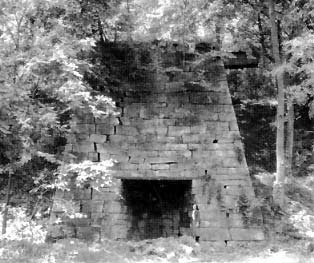
 soon established farther west. In 1794, Peter Tarr built one of the first iron
furnaces west of the Alleghenies on Kings Creek near Weirton, in Hancock County.
As well as making cooking utensils and iron grates, this furnace also cast the
cannonballs used by Commodore Oliver H. Perry in the 1813 Battle of Lake Erie.
Most of the iron furnaces were built in the Cheat River Valley near Ices Ferry
and along Deckers Creek in the Monongahela River Valley. The Decker's Creek
Iron Works, also called Rock Forge, produced bar iron as early as 1798,
although the most extensive iron works were on the Cheat River. At Pleasant
Furnace, built on Quarry Run about 1798, Samuel Jackson produced large quantities
of bar iron and sold it in exchange for cash, grain, and country products.
Since the Pleasant (Davis) Furnace was small, it did not supply enough iron
for Jackson's use. So new furnaces were built, such as Woodgrove, Henry Clay,
and Anna, all near Ices Ferry on the Cheat River. Since iron manufacturers
preferred charcoal over coal for the furnaces, the lumber industry in the area
was encouraged and thrived. During its peak years, in the 1840s, the Jackson
Iron Works was a well-known establishment, employing as many as 1,200 workers.
A thriving community developed with over 100 homes, four times the
size of nearby Morgantown.
Iron manufacturing and related industries also prospered in the Northern
Panhandle. In 1832, a large iron mill was constructed at Wheeling. The major
product was nails, which gave the city the nickname of "Nail City."
However, by the mid-1800s, transportation methods were improving and new and
richer iron ore beds were being discovered around Lake Superior. In 1880,
rich, thick, iron ore beds were found in the Mesabi Range in Minnesota and
Michigan. A better railroad system made transportation of this ore economical,
and the small iron ore furnaces of West Virginia could not compete. By World
War I, only one iron mine, near Harpers Ferry, was still in operation.
At present, West Virginia cannot compete with the more accessible, large
reserves of other states. However, there is iron in the State which could
become a valuable resource if it is ever in short supply.
(adapted from an article by Jane R. Eggleston, updated September 1996)
soon established farther west. In 1794, Peter Tarr built one of the first iron
furnaces west of the Alleghenies on Kings Creek near Weirton, in Hancock County.
As well as making cooking utensils and iron grates, this furnace also cast the
cannonballs used by Commodore Oliver H. Perry in the 1813 Battle of Lake Erie.
Most of the iron furnaces were built in the Cheat River Valley near Ices Ferry
and along Deckers Creek in the Monongahela River Valley. The Decker's Creek
Iron Works, also called Rock Forge, produced bar iron as early as 1798,
although the most extensive iron works were on the Cheat River. At Pleasant
Furnace, built on Quarry Run about 1798, Samuel Jackson produced large quantities
of bar iron and sold it in exchange for cash, grain, and country products.
Since the Pleasant (Davis) Furnace was small, it did not supply enough iron
for Jackson's use. So new furnaces were built, such as Woodgrove, Henry Clay,
and Anna, all near Ices Ferry on the Cheat River. Since iron manufacturers
preferred charcoal over coal for the furnaces, the lumber industry in the area
was encouraged and thrived. During its peak years, in the 1840s, the Jackson
Iron Works was a well-known establishment, employing as many as 1,200 workers.
A thriving community developed with over 100 homes, four times the
size of nearby Morgantown.
Iron manufacturing and related industries also prospered in the Northern
Panhandle. In 1832, a large iron mill was constructed at Wheeling. The major
product was nails, which gave the city the nickname of "Nail City."
However, by the mid-1800s, transportation methods were improving and new and
richer iron ore beds were being discovered around Lake Superior. In 1880,
rich, thick, iron ore beds were found in the Mesabi Range in Minnesota and
Michigan. A better railroad system made transportation of this ore economical,
and the small iron ore furnaces of West Virginia could not compete. By World
War I, only one iron mine, near Harpers Ferry, was still in operation.
At present, West Virginia cannot compete with the more accessible, large
reserves of other states. However, there is iron in the State which could
become a valuable resource if it is ever in short supply.
(adapted from an article by Jane R. Eggleston, updated September 1996)
Please send questions, comments, and/or suggestions to webmaster.
Page created and maintained by:
West Virginia Geological and Economic Survey
Address: Mont Chateau Research Center
1 Mont Chateau Road
Morgantown, WV 26508-8079
Telephone: 304-594-2331
FAX: 304-594-2575
Hours: 8:00 a.m. - 5:00 p.m. EST, Monday - Friday
Permission to reproduce this material is granted if acknowledgment is given to the West Virginia Geological and Economic Survey.